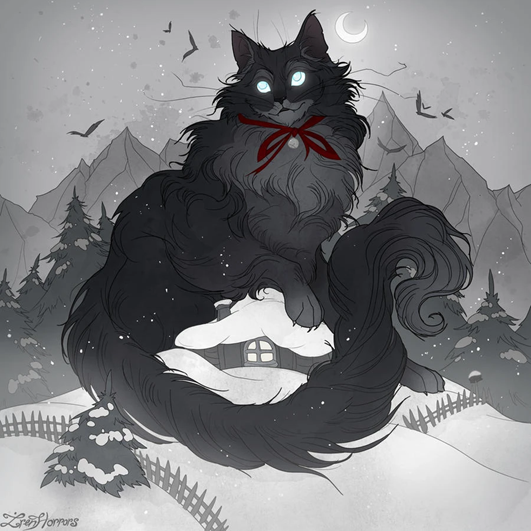
*Warning: The following article contains details that might be a little frightening for younger children*
The holidays are right around the corner, and many cultures have different stories surrounding this special time. Specifically, many European countries have plenty of these legends, such as Krampus and Belsnickel (Germany), The Yule Goat (Sweden), and La Befana (Italy and Russia). However, there is one Christmas legend who just may fit in right here at Turpentine! The Yule Cat, or Jólakötturinn, is an Icelandic legend that may be over 1,000 years old!
What is the Yule Cat?
The Yule Cat is said to be the pet of Grýla, a giant ogre, and her 13 children, the Yule Lads. It is described as being “huge”, typically larger than a building, with dark fur and sharp whiskers. It also is shown to have glowing eyes, which can be blue, red or yellow. The Yule Cat usually resembles the Norwegian Forest Cat, which is a breed of domesticated house cat with a long, wooly coat perfect for chilly temperatures, and is sometimes shown wearing a red collar with a large bell, but not always!

The cat’s personality can range from simply unruly, to truly evil. Sometimes the cat stays by Grýla’s side, and in other stories, it is the companion of Stúfur, the youngest of the Yule Lads. There are not many stories revolving around the Yule Cat though, and all of them involve its activities on Christmas night. Who knows what it does the other 364 days of the year?
The Legend
The Yule Cat is said to look in the windows of each and every house it passes by on Christmas night. It looks through the presents the children have received. If they have received new clothes, specifically socks, the Cat will move on. However, if the child did not work hard enough to receive a pair of socks, the Yule Cat will eat the child. Children of wealthier families were encouraged to donate extra pairs of socks to less fortunate families, so as to provide protection against the Yule Cat.
It seems that the legend of the Yule Cat began spreading as a way to encourage farmers to finish their work in a timely manner, so that there was enough wool, leather, and other supplies to make clothing for everyone. However, clever parents thought that this could also be a way to convince their children to do their chores, to ensure they get a pair of socks on Christmas morning. The legend of the Yule Cat has been used to promote hard work, timeliness, and good-fortune amongst the children of Iceland.
The Origins
There are a lot of conflicting thoughts on how the story of the Yule Cat originated. The first is that the legend came from a figure of speech that roughly translates to “dress the cat”, and was misinterpreted to be a monster by later authors. Another is that the Yule Cat was a traditional follower of Saint Nicholas (who we now call Santa Claus!). Yet another is that the Yule Cat dates back to traditional Christmas celebrations, where performers would dress up as animals and dance.
No matter its origins, the Yule Cat has become a staple of traditional Icelandic Christmas celebrations. In the 1970s, a song was developed based on poems from Jóhannes úr Kötlum, one of which being the story of the Yule Cat. This song became popular across the country in 1987, and with it the Yule Cat gained popularity. Many Icelandic homes were decorated with cat-themed items around the holidays in the spirit of the Yule Cat. The capital city of Reykjavik even created a 16-foot tall statue of the Yule Cat to place in their city square in 2018! Hopefully, this tradition will help you find a newfound appreciation for Christmas socks!
Sources
The Yule Cat – Icelandic Folklore
24 Christmas Creatures & Monsters To Look Out For In December (dreams.co.uk)
